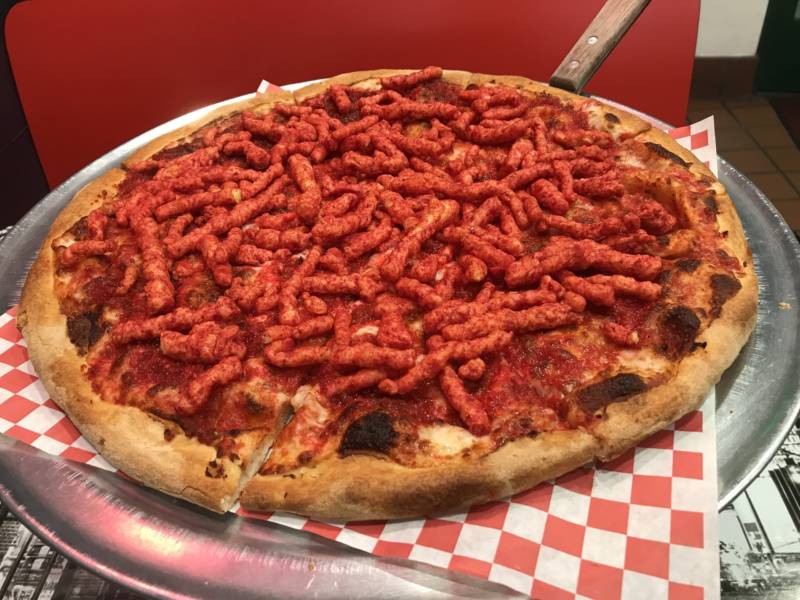Flamin' Hot Cheetos have always been a part of Gustavo Arellano's life, in one way or another.
Flamin’ Hot Cheetos: The Humble Beginnings of a Junk Food

"Before the invention of Flamin' Hot Cheetos, we Mexican kids would just get a bag of Cheetos and put a bunch of Tapatío on it so they are already flaming hot," said Arellano, features writer for the Los Angeles Times.
Richard Montañez was one of those kids.
Montañez was born in Mexico, but grew up in Southern California picking grapes on a migrant labor farm with his 10 siblings. He dropped out of school at a young age, and in 1976 — without knowing how to read or write — got a job as a janitor at Frito-Lay in Rancho Cucamonga.
Montañez had been working there for nearly two decades when one day, while mopping floors, he noticed something was wrong. Cheetos were getting pumped out without any of their signature neon-orange flavoring on top. He decided to take a few of these “blank” Cheetos home to experiment with some of his favorite spices : things he had grown up eating on the burritos his mom packed him for lunch, the elote or corn he bought from street vendors.
He made his own chili and put it on top of the Cheetos. Pleased with the results, he took his creation to work, where everyone agreed it tasted great.
Frito-Lay had just launched a campaign to empower its workers, and Montañez took those words to heart. He read a library book on market strategy, bought a $2 tie and called up the company's CEO: He told him he had an idea for how to break into the Latino market, and Flamin’ Hot Cheetos was born.
I reached out to Montañez for this story, but got no response. He has publicly spoken about his path to invention and written an autobiography, too.
Arellano said, "Montañez's genius was that he was bold enough to go up to his bosses and say, 'Hey, look, this would be a really great idea.' And the bosses were smart enough to run with the idea."
Decades later, Montañez's creation is one of Frito-Lay's top-selling products, and he is an executive at PepsiCo — quite the “rags to riches” tale, but it’s not where the story ends.
These days, Flamin’ Hot Cheetos are ingrained in pop culture.
From hip-hop music ...
... to eBay ...
... And Katy Perry's Halloween costume.
"[Flamin' Hot] is not a flavor ... it transcends flavor, it transcends food… that’s why it just hits people, that’s why it stays with people so much," said Arellano, author of "Taco USA: How Mexican Food Conquered America."

It hasn’t all been good publicity, though. In 2012, schools in Pasadena banned Flamin’ Hot Cheetos from their campuses, citing “nutritional concerns.”
But that hasn’t stopped chefs from creating dishes inspired by the red hot snack, like steaks, burritos, sushi and pizza.
Hayk Igraryan, owner of Ameci Pizza Kitchen in Glendale, claims to be the inventor of the Flamin’ Hot Cheetos pizza.

Igraryan said when he was a kid, he used to save his lunch money to buy Flamin' Hot Cheetos. Now, his pizza shop serves up a pie dedicated to the snack.
"The secret's really in all three combined: the sauce, the cheese and the dough," he said, showing me how they crush up Cheetos into the sauce, bake the pizza in the oven, and top it with a layer of Flamin' Hot Cheetos once it's cooled.
Igraryan says people see the photos of the hot Cheeto pizza on social media and come from all over — from Texas to China — to try it.

But the most surprising thing to me about the story of Flamin’ Hot Cheetos (besides the fact that people are putting them on pizzas) is Montañez’s story. It hasn’t been co-opted by big companies claiming the invention as their own. It hasn’t been mythified or whitewashed.
Arellano said this is rare: "When it comes to Mexican food, there [are] so many origins stories ... and almost all of them are just a bunch of lies. The Flamin' Hot Cheetos origin story is one of the very few that has actually been verified."
Not only is it verified, a feature film about Montañez is in the works. Arellano says Hollywood doesn’t have nearly enough stories showing Latinos in a positive light, but Montañez's life is the perfect inspirational tale, featuring a unique snack.